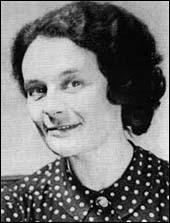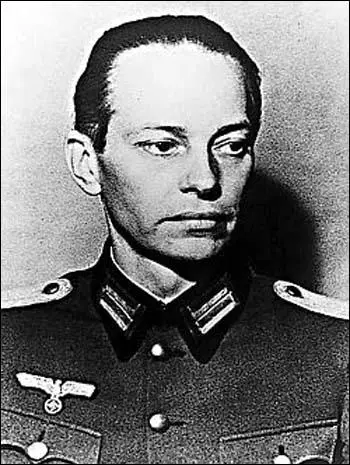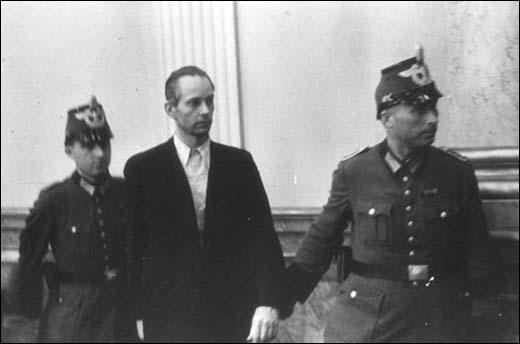Marion Yorck von Wartenburg

Marion Yorck von Wartenburg was born Marion Winter in Berlin on 14th June 1904. She was the third of six children of a senior civil servant responsible for the German state's role in supporting the performing arts. Marion was educated at the Grunewald-Gymnasium in Berlin. A fellow student was Dietrich Bonhoeffer. She went on to university there to study medicine, but switched to law, in which she gained a doctorate at the age of 25. "Unusually for a woman at the time, she started training as a judge, a career separate from advocacy in Germany." (1)
In 1930 she married Peter Graf Yorck von Wartenburg, a year older, whom she had met while they were both studying law. Although her background was upper middle class, Marion's marriage to a landed aristocrat from a family with several estates led her to give up the law and help with the management of the estate. (2)
In 1936 Wartenburg was appointed as assistant secretary to the Reich Price Commission in Berlin. He refused to join the Nazi Party and therefore never received any further promotions. Some of his associates, including Hans Gisevius, a former assistant secretary in the Ministry of the Interior, was also strongly opposed to Adolf Hitler. (3)
Wartenburg opposition to fascism increased after Kristallnacht (9-10 November 1938). In 1940 along with Helmuth von Moltke he established the Kreisau Circle, a small group of intellectuals who opposed Hitler. Other people who joined included Adam von Trott, Fritz-Dietlof von der Schulenburg, Wilhelm Leuschner, Julius Leber, Adolf Reichwein, Carlo Mierendorff, Alfred Delp, Eugen Gerstenmaier, Ulrich-Wilhelm Graf von Schwerin, Dietrich Bonhoffer, Harald Poelchau and Jakob Kaiser. Marion and Freya von Moltke, were the only women who attended these meetings. (4) It has been pointed out that they "could have faced the death penalty simply for serving food and drinks to the conspirators." (5)
The group represented a broad spectrum of social, political, and economic views, they were best described as Christian and Socialist. A. J. Ryder has pointed out that the Kreisau Circle "brought together a fascinating collection of gifted men from the most diverse backgrounds: noblemen, officers, lawyers, socialists, trade unionists, churchmen." (6) Joachim Fest argues that the "strong religious leanings" of this group, together with its ability to attract "devoted but undogmatic socialists," but has been described as its "most striking characteristic." (7)

On 8th January, 1943, a group of conspirators, including, Helmuth von Moltke, Fritz-Dietlof von der Schulenburg, Johannes Popitz, Ulrich Hassell, Eugen Gerstenmaier, Adam von Trott, Ludwig Beck and Carl Goerdeler met at Wartenburg's home. Hassell was uneasy with the utopianism of the of the Kreisau Circle, but believed that the "different resistance groups should not waste their strength nursing differences when they were in such extreme danger". Wartenburg, Moltke and Hassell were all concerned by the suggestion that Goerdeler should become Chancellor if Hitler was overthrown as they feared that he could become a Alexander Kerensky type leader. (8)
Claus von Stauffenberg decided to carry out the assassination himself. But before he took action he wanted to make sure he agreed with the type of government that would come into being. Conservatives such as Carl Goerdeler and Johannes Popitz wanted Field Marshal Erwin von Witzleben to become the new Chancellor. However, socialists in the group, such as Julius Leber and Wilhelm Leuschner, argued this would therefore become a military dictatorship. At a meeting on 15th May 1944, they had a strong disagreement over the future of a post-Hitler Germany. (9)
Peter Graf Yorck von Wartenburg was arrested along with Fritz-Dietlof von der Schulenburg and Friedrich Olbricht. His trial took place on 7th August, 1944. It resulted in the conviction of Peter Yorck von Wartenburg, Field Marshal Erwin von Witzleben, Colonel-General Erich Hoepner, General-Major Helmuth Stieff, General Paul von Hase (the commandant of the Berlin garrison) and several junior officers. All the men were tried by Roland Freisler, the notorious Nazi judge. (10)

Joseph Goebbels ordered that every minute of the trial should be filmed so that the movie could be shown to the troops and the civilian public as an example of what happened to traitors. (11) Peter Graf Yorck von Wartenburg wrote in his last letter to his wife: "I believe I have gone some way to atone for the guilt which is our heritage." (12) Wartenburg was particularly fearless and steadfast. He told the court: "The vital point running through all these questions is the totalitarian claim of the state over the citizen to the exclusion of his religious and moral obligation toward God." (13)
It is estimated that 4,980 people were arrested by the Gestapo. Heinrich Himmler gave instructions that these men should be tortured. He also ordered that family members should also be punished: "When they (the people's Germanic forbears) put a family under the ban and declared it outlawed or when there was a vendetta in the family, they were totally consistent about it. If the family was outlawed or banned; it will be exterminated. And in a vendetta they exterminated the entire clan down to its last member. The Stauffenberg family will be exterminated down to its last member." (14)
Marion was arrested and put in solitary confinement for three months. What became known as the "kith and kin" law, was a particularly sophisticated form of torture. When interrogating suspects the Gestapo could, quite legally, threaten to ill-treat their wives, children, parents, brothers and sisters or other relatives. (15)
Released without charge, she managed to get to the Yorck estates, which were soon overrun by the advancing Red Army. Although she eluded the attentions of Soviet soldiers, she was jailed again in Poland for another three months and beaten up by communist guards who refused to accept that she was not a supporter of fascism.
After the war, Marion Yorck went back to being a judge, helped by her record as an anti-Nazi, and acquired a reputation as fair but firm in the criminal trials she supervised. The Yorcks had no children and Marion did not remarry, keeping the Yorck family name in honour of her husband. But for half a century she lived with Ulrich Biel, a German politician. (16).
Marion Yorck von Wartenburg died aged 102 on 13th April, 2007.
Primary Sources
(1) Dan van der Vat, The Guardian (21st May, 2007)
Marion, Countess Yorck von Wartenburg, who has died in Berlin aged 102, was one of the last survivors of the Kreisauer Kreis (or Kreisau circle) of aristocrats, academics, senior civil servants and other leaders of pre-Nazi society whose ideas for a democratic regeneration of postwar Germany cost them their lives.
The group took its name from the Kreisau estate, now in Polish Silesia, of Helmuth James Count von Moltke, who formed it with von Wartenburg's husband, Peter Count Yorck von Wartenburg, in 1940. Both were descended from Prussian field marshals whose victories over the French in the 19th century laid the foundations for the unification of Germany in 1870-71 and its emergence as the leading European economic and military power.
The circle, which usually met on the estate, is commonly described as part of the resistance to Hitler, which most historians agree did not amount to much. Its members described the circle as no more than a discussion group, expressly opposed to a coup d'état or political violence. Yet in Nazi Germany even that amounted to treason.
There is no denying the moral and physical courage of Kreisauer members, so many of whom were horribly executed for their beliefs. As Count Yorck wrote in his last letter to Marion before his execution in August 1944: "I believe I have gone some way to atone for the guilt which is our heritage."
Appalled by Hitler and the Nazi stain on the name of Germany, the members took it as read that he would be defeated by the Allies in the second world war, and agonised over the utopian shape of a democratic, Christian-socialist state that would rise from the ruins. It was a very German manifestation of idealism, and even mysticism, that had nothing to say about how the Germans themselves might make a practical contribution to their own salvation by deposing the regime the group blamed for their country's plight. As William Shirer, historian of the Third Reich, wrote: "Moltke and his friends had the courage to talk - for which they were executed - but not to act."
Marion Winter was born in Berlin, the daughter of a senior civil servant responsible for the German state's role in supporting the performing arts. After school in her home city, she went on to university there to study medicine, but switched to law, in which she gained a doctorate at the age of 25. Unusually for a woman at the time, she started training as a judge, a career separate from advocacy in Germany.
In 1930, however, she married Peter Yorck, a year older, whom she had met while they were both studying law. Although her background was upper middle class, Marion's marriage to a landed aristocrat from a family with several estates (awarded to the field-marshal ancestor) led her to give up the law and help with the progressive management of the estate that her husband took over from his brother, who was killed in action in 1942.
Although opposed to violence, Kreisau members inevitably came into contact and conversed with the military plotters who were bent on deposing Hitler by force and had made several ineffectual attempts on his life. Peter Yorck was working in the war office, where Claus Count von Stauffenberg and other army officers were planning to assassinate Hitler with a bomb at his headquarters at Rastenburg on July 20 1944 and take over power using the home army. The military plotters were largely motivated by Germany's impending defeat and wanted to prevent Hitler taking the country down with him. But he miraculously survived the blast and took a terrible revenge on all those involved or suspected of involvement - including anyone who had dared to question the regime, such as the Kreisau circle.
Student Activities
The Political Development of Sophie Scholl (Answer Commentary)
The White Rose Anti-Nazi Group (Answer Commentary)
Kristallnacht (Answer Commentary)
Adolf Hitler's Early Life (Answer Commentary)
Heinrich Himmler and the SS (Answer Commentary)
Trade Unions in Nazi Germany (Answer Commentary)
Adolf Hitler v John Heartfield (Answer Commentary)
Hitler's Volkswagen (The People's Car) (Answer Commentary)
Women in Nazi Germany (Answer Commentary)
German League of Girls (Answer Commentary)
